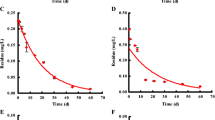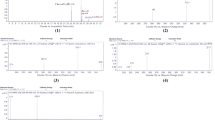Abstract
Rice is one of the most important food crops worldwide. However, it is also a valuable tool in assessing toxicity of organic and inorganic compounds. Fipronil insecticide has been widely used to control rice pests. The research was conducted to evaluate the fate of fipronil in rice-field. Persistence and metabolism of fipronil in rice is studied by applications of Regent 0.3G @ 45 and 180 g a.i. ha−1 was made 7 days after transplanting of paddy. Samples of paddy plants were collected at 7, 15, 30, 45, 60, 90 and 120 days after the application of insecticide. The samples of rice grains, bran, husk and straw were collected at the time of harvest. The samples were extracted and cleaned up by following a standardized methodology. Fipronil and its metabolites were quantified by gas liquid chromatography and confirmed by gas chromatography mass spectrometer. The total residues of fipronil and its metabolites in paddy plants after 7 days of its application at recommend and four times of recommend doses were found to be 6.60 and 19.85 mg kg−1, respectively. Among fipronil metabolites, sulfone derivative had maximum residue concentration followed by other metabolites viz. sulfide, amide and desulfinyl. The residues were reached below the detectable limit (0.01 mg kg−1) after 45 and 90 days at recommend and four time of recommend doses, respectively. At harvest, the samples of paddy straw, rice grains, bran and husk did not reveal the presence of fipronil and its metabolites.
Similar content being viewed by others
References
Aajoud A, Ravanel P, Tissut M (2003) Fipronil metabolism and dissipation in a simplified aquatic ecosystem. J Agric Fd Chem 51:1347–1352
Anonymous (2009a) www.indiastat.com
Anonymous (2009b) Package of practices for Kharif crops. Punjab Agricultural University, Ludhiana, pp 1–23
Chanton PF, Ravanel P, Tissut M, Meyran JC (2001) Toxicity and bioaccumulation of fipronil in the nontarget arthropodan fauna associated with subalpine mosquito breeding. Ecotoxi Envir Saf 52:8–12
Connelly P (2001) Environmental fate of fipronil. Environment monitoring branch, Department of pesticide regulation, California environmental protection agency, www.pw.ucr.edu/textfiles/fipronil.pdf
Hainzal D, Casida JE (1996) Fipronil insecticide: novel photochemical desulfinylation with retention of neurotoxicity. Proc Natl Acad Sci 93:12764–12767
Huggan RD (1995) Co-evolution of rice and humans. Geo J 35(3):262–265
Lal OP (1996) Recent advances in entomology. In: Lal OP (ed) Recent advances in indian entomology, APC Publications Private Limited, New Delhi, p 392
Mahal MS, Sarao PS, Singla ML (2008) Bioefficacy of fipronil 80 per cent WG for the control of stem borer and leaf folder in basmati rice. Indian J Plant Protec 36:260–262
Mani A, Prasad NN (1985) Persistence pattern of disyston in soil and rice plants. Indian J Plant Protec 13:5–8
Mohapatra S, Deepa M, Jagdish GK, Rashmi N, Kumar S, Prakash GS (2010) Fate of fipronil and its metabolites in/on grape, leaves, berries and soil under semi arid tropical climate conditions. Bull Environ Contam Toxicol 84:587–591
Pei Z, Yitong L, Baofeng L, Gan JJ (2004) Dynamics of fipronil residues in vegetable field ecosystem. Chemosphere 57:1691–1696
Rai M (2004) International year of rice-an overview. Indian Farm 58:3–6
Rajukkannu K, Balasubramanian M, Lakshmanan PL (1983) Degradation and persistence of certain organophosphorus insecticide residues in rice. Indian J Plant Protec 11:96–97
Sekh K, Nair N, Chakraborty S, Somchoudhoudhury AK (2007) Efficacy of fipronil 80 per cent against stem borer and leaf folder. Pestology 32:39–41
Skidmore MW, Ambrus A (2004) Pesticide metabolism in crops and livestock. In: Hamilton D, Crossley S (eds) Pesticide residues in food and drinking water: human exposure and risks. Wiley, London, pp 63–120
Acknowledgments
The authors are grateful to the Head, Department of Entomology, Punjab Agricultural University Ludhiana for providing necessary facilities.
Author information
Authors and Affiliations
Corresponding author
Rights and permissions
About this article
Cite this article
Kumar, R., Singh, B. Persistence and Metabolism of Fipronil in Rice (Oryza sativa Linnaeus) Field. Bull Environ Contam Toxicol 90, 482–488 (2013). https://doi.org/10.1007/s00128-012-0926-y
Received:
Accepted:
Published:
Issue Date:
DOI: https://doi.org/10.1007/s00128-012-0926-y




